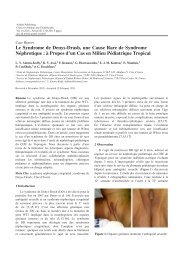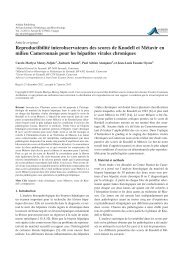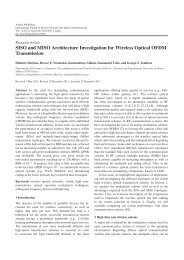Devenir materno-fœtal après application de ventouse obstétricale ...
Devenir materno-fœtal après application de ventouse obstétricale ...
Devenir materno-fœtal après application de ventouse obstétricale ...
Create successful ePaper yourself
Turn your PDF publications into a flip-book with our unique Google optimized e-Paper software.
Clinics in Mother and Child Health 3<br />
5 Conclusion<br />
Le taux d’utilisation <strong>de</strong> la <strong>ventouse</strong> <strong>obstétricale</strong> est très<br />
faible dans notre contexte. On note un fort taux <strong>de</strong> succès<br />
et très peu <strong>de</strong> complications maternelles et néonatales.<br />
Cet instrument mérite d’être mieux connu et plus utilisé<br />
en Afrique francophone. Ceci passe par la formation<br />
du personnel (mé<strong>de</strong>cins et sages-femmes) d’autant que<br />
l’apprentissage est plus facile que celui du forceps. Il s’agit<br />
aussi bien <strong>de</strong> la formation initiale que <strong>de</strong> la formation<br />
continue afin <strong>de</strong> maintenir la compétence [6].<br />
Bibliographie<br />
[1] S. E. Adaji, S. T. Shittu, and S. O. Sule, Operative vaginal<br />
<strong>de</strong>liveries in Zaria, Nigeria, Ann Afr Med, 8 (2009), 95–99.<br />
[2] C. E. Balecoidjo, Accouchement assisté par <strong>ventouse</strong>: à propos<br />
<strong>de</strong> 147 cas à la maternité du CHU <strong>de</strong> Cocody, thèse Med, UFR<br />
<strong>de</strong>s Sciences Médicales, Abidjan, Côte d’Ivoire, 2005.<br />
[3] O. Baud, Complications néonatales <strong>de</strong>s extractions instrumentales,<br />
La Revue Sage-Femme, 8 (2009), 187–195.<br />
[4] Y. M. Cargill and C. J. MacKinnon, Directives cliniques sur<br />
l’accouchement vaginal opératoire, J Obstet Gynaecol Can, 26<br />
(2004), 754–761.<br />
[5] D.P.DamronandE.L.Capeless,Operative vaginal <strong>de</strong>livery: A<br />
comparison of forceps and vacuum for success rate and risk of<br />
rectal sphincter injury, Am J Obstet Gynecol, 191 (2004), 907–<br />
910.<br />
[6] O. Dupuis, Formation et apprentissage <strong>de</strong>s extractions, J Gynecol<br />
Obstet Biol Reprod, 37 (2008), S288–S296.<br />
[7] O. Dupuis, R. Silveira, T. Redarce, A. Dittmar, and R.-C.<br />
Rudigoz, Extraction instrumentale au sein du réseau Aurore:<br />
inci<strong>de</strong>nce et complications néonatales graves, Gynécol Obstét<br />
Fertil, 31 (2003), 920–927.<br />
[8] L. C. Ezenagu, R. Kakaria, and J. A. Bofill, Sequential. Use of<br />
instruments at operative vaginal <strong>de</strong>livery: Is it safe?,AmJObstet<br />
Gynecol, 180 (1999), 1446–1449.<br />
[9] V. Fauveau, Is vacuum extraction still known, taught and<br />
practiced? A worldwi<strong>de</strong> KAP survey, Int J Gyn Obstet, 94 (2006),<br />
185–189.<br />
[10] J. R. Gachiri and K. O. Rogo, Foetal and maternal outcome of<br />
vacuum extraction, East Afr Med J, 68 (1991), 539–546.<br />
[11] R. B. Johanson and V. Menon, Vacuum extraction versus forceps<br />
for assisted vaginal <strong>de</strong>livery, Cochrane Database Syst Rev,<br />
(2010), CD000224.<br />
[12] S. Lurie, T. M. Glezerman, and O. Sadan, Maternal and neonatal<br />
effects of forceps versus vacuum operative vaginal <strong>de</strong>livery,IntJ<br />
Gyn Obstet, 89 (2005), 293–294.<br />
[13] R. A. Mesleh, H. M. Al-Sawadi, and A. M. Kurdi, Comparison<br />
of maternal and infant outcomes between vacuum extraction and<br />
forceps <strong>de</strong>liveries, Saudi Med J, 23 (2002), 811–813.<br />
[14] S. Miot, D. Riethmuller, K. Dele-Plancque, O. Teffaud, M. Martin,<br />
R. Maillet, et al., 14 césariennes pour échec d’extraction<br />
par <strong>ventouse</strong> <strong>obstétricale</strong>: facteurs <strong>de</strong> risque et conséquences. à<br />
propos <strong>de</strong> 2 447 cas au chu <strong>de</strong> Besançon, J Gynecol Obstet Biol<br />
Reprod, 33 (2004), 68–69.<br />
[15] F. Pierre and M. Jousse, Aspects médico-légaux <strong>de</strong>s extractions<br />
instrumentales, J Gynecol Obstet Biol Reprod, 37 (2008), S276–<br />
S287.<br />
[16] D. Riethmuller, L. Courtois, and R. Maillet, Pratique libérale<br />
versus restrictive <strong>de</strong> l’épisiotomie: existe-t-il <strong>de</strong>s indications<br />
<strong>obstétricale</strong>s spécifiques <strong>de</strong> l’épisiotomie?, J Gynecol Obstet Biol<br />
Reprod, 35 (2006), 32–39.<br />
[17] D. Riethmuller, R. Ramanah, R. Maillet, and J.-P. Schaal, Ventouse:<br />
<strong>de</strong>scription, mécanique, indications et contre-indications,<br />
J Gynecol Obstet Biol Reprod, 37 (2008), S210–S221.<br />
[18] J. Schaal, D. Riethmuller, and A. Menget, Ventouse <strong>obstétricale</strong>,<br />
EMC-Gynécologie-Obstétrique, 1 (2004), 156–179.<br />
[19] J.-P. Schaal, V. Epuy, and P. Hoffman, Comparaison <strong>ventouse</strong><br />
forceps, J Gynecol Obstet Biol Reprod, 37 (2008), S244–S259.<br />
[20] B. Traoré, T. A. Thera, C. Kokaina, N. Mounkoro, I. Teguete, and<br />
Y. Traore, Les extractions instrumentales à la maternité du CHR<br />
<strong>de</strong> Ségou au Mali. Etu<strong>de</strong> rétrospective sur 12 mois à propos <strong>de</strong><br />
87 cas, Med Afr Noire, 57 (2010), 71–76.<br />
[21] S. Vanlieferinghen, G. Girard, and L. Man<strong>de</strong>lbrot, E’tu<strong>de</strong><br />
comparative <strong>de</strong> la morbidité <strong>materno</strong>-<strong>fœtal</strong>e immédiate <strong>de</strong>s<br />
extractions par spatules <strong>de</strong> Thierry et par <strong>ventouse</strong>s, J Gynecol<br />
Obstet Biol Reprod, 38 (2009), 648–654.








